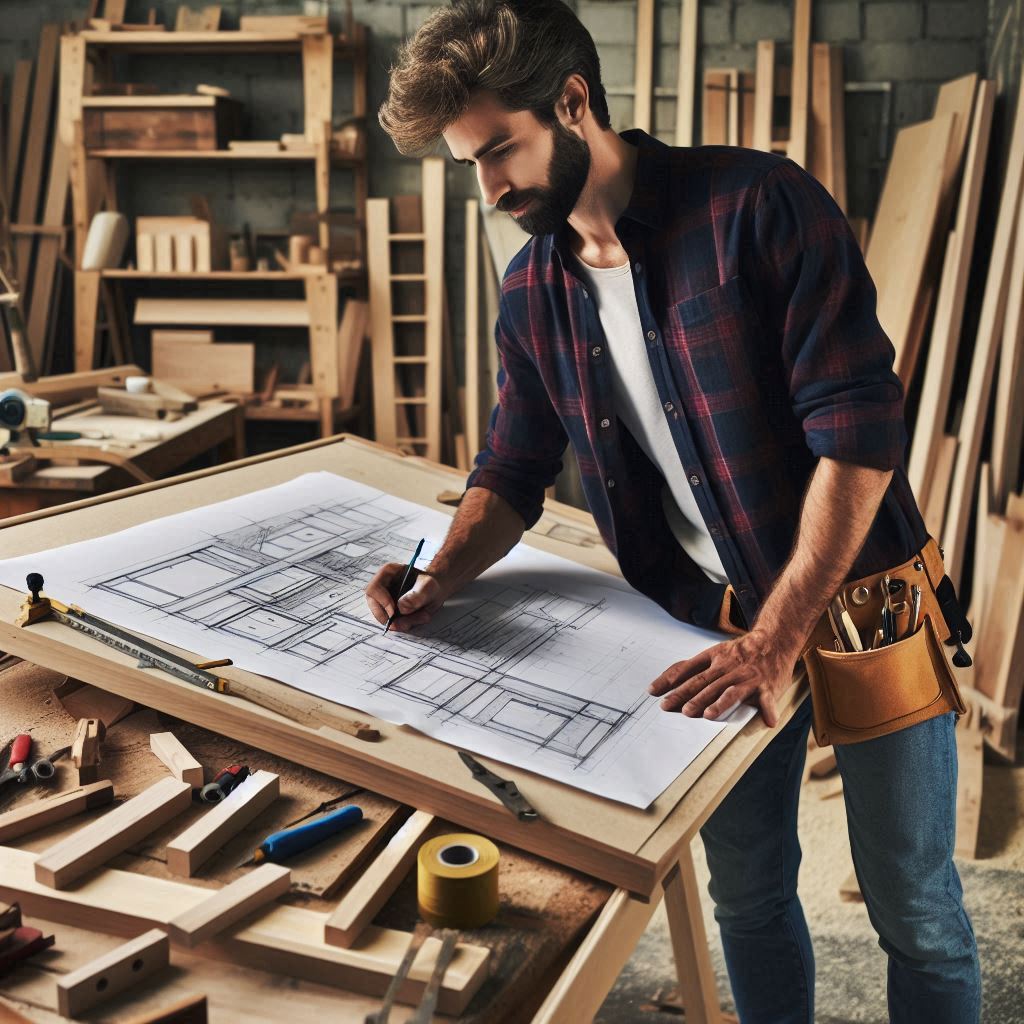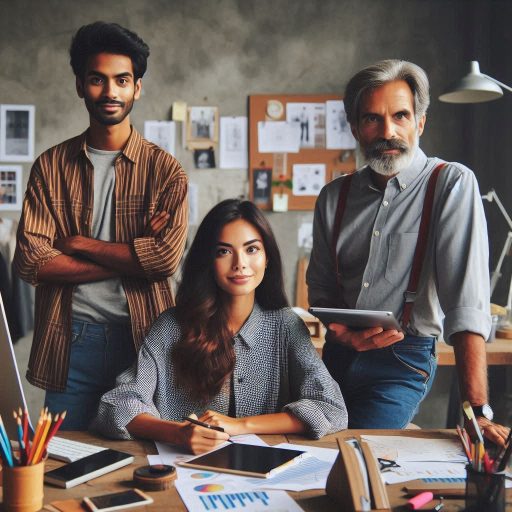Introduction
3D printing technology has transformed numerous industries, including furniture design.
By layering materials to form precise shapes, 3D printing allows designers to create intricate and customizable furniture pieces.
This innovative method reduces both time and cost traditionally associated with furniture manufacturing, offering designers greater flexibility.
In furniture design, 3D printing enables the creation of complex, unique items that would be difficult or impossible to produce by hand.
Designers can explore intricate geometries and forms that push the boundaries of traditional craftsmanship.
This technology also minimizes waste, as only the required materials are used during the printing process, contributing to more sustainable production methods.
Incorporating 3D printing is essential in today’s design industry.
It helps designers stay ahead of the curve by embracing new possibilities and enhancing creativity.
The ability to produce one-of-a-kind pieces quickly and efficiently sets 3D printing apart from conventional manufacturing methods.
As this technology continues to evolve, it will play a pivotal role in shaping the future of furniture design, enabling endless innovation and customization.
Understanding the basics of 3D printing
3D printing, also known as additive manufacturing, is a process that creates objects layer by layer.
It transforms digital designs into physical products using various materials like plastic, metal, or even wood composites.
Designers feed a 3D model into a printer, which builds the object by stacking thin layers of material.
This technique allows for precise control over shapes and structures, making it an ideal tool for furniture design.
Different Types of 3D Printing Technologies
Several types of 3D printing technologies exist, each suited to specific purposes.
The most common ones used in furniture design include Fused Deposition Modeling (FDM), Stereolithography (SLA), and Selective Laser Sintering (SLS).
Fused Deposition Modeling (FDM)
Fused Deposition Modeling (FDM) is the most widely used and accessible type of 3D printing.
It works by melting a plastic filament, which is then extruded layer by layer to form the object.
FDM is popular in furniture design for creating prototypes or custom pieces quickly and affordably.
It’s a favorite for small-scale designers looking to experiment with unique shapes.
Stereolithography (SLA)
Stereolithography (SLA) uses a laser to cure liquid resin into a solid object, layer by layer.
This method allows for high precision and smooth finishes, making it ideal for intricate designs or detailed furniture components.
Designers use SLA to create highly aesthetic pieces or parts that require more refined surfaces.
Selective Laser Sintering (SLS)
Selective Laser Sintering (SLS) works by using a laser to fuse powdered material together.
Unlike FDM or SLA, SLS doesn’t require support structures, allowing for more complex shapes.
This method is particularly useful for creating durable, functional furniture pieces that can withstand daily use.
Benefits of Using 3D Printing in Furniture Design
Using 3D printing in furniture design offers several advantages.
One of the biggest benefits is customization.
3D printing allows designers to create bespoke furniture pieces tailored to individual customer needs.
Whether it’s a chair that fits a specific body shape or a table that matches the exact dimensions of a space, 3D printing enables personalization on an unprecedented level.
Another significant benefit is efficiency.
Traditional furniture manufacturing often requires molds and multiple steps, which can be time-consuming and costly.
3D printing eliminates many of these steps, allowing designers to quickly produce prototypes or final products.
This reduces both production time and cost.
Sustainability is another advantage.
3D printing uses only the material necessary to create the object, reducing waste.
Designers can also experiment with eco-friendly materials like recycled plastics or biodegradable composites, promoting sustainable practices in the furniture industry.
Understanding 3D printing technologies and their benefits opens new doors for innovation in furniture design.
By adopting this technology, designers can create customized, efficient, and sustainable furniture pieces with ease.
Read: Visual Merchandiser: Job Market and Opportunities
Choosing the right 3D printing software
Selecting the right 3D printing software is crucial for furniture design success.
The software acts as the bridge between your creative ideas and the final printed object.
It allows you to design, model, and refine your furniture before printing.
With so many options available, choosing the right software can seem overwhelming.
Let’s explore some popular programs and key features to consider when making your decision.
Overview of Popular 3D Printing Software Programs
Several 3D printing software programs are popular among furniture designers.
Each offers unique features, depending on your needs and experience level.
Fusion 360
Fusion 360 is widely regarded for its versatility and ease of use.
It combines CAD (computer-aided design) and CAM (computer-aided manufacturing) capabilities, making it a powerful tool for furniture design.
Fusion 360 is great for creating complex, detailed furniture pieces and offers built-in simulation tools.
Tinkercad
Tinkercad is another popular option, especially for beginners.
It’s a free, web-based tool that allows designers to create simple 3D models using basic shapes.
While it’s not as advanced as Fusion 360, Tinkercad is ideal for quick prototyping and learning the basics of 3D design.
Blender
Blender is a free, open-source program used for more advanced 3D modeling and sculpting.
It’s favored by designers looking to create artistic or highly detailed furniture pieces.
Blender’s steep learning curve pays off with a wide range of powerful tools for precision and customization.
Features to Look for in a 3D Printing Software Program for Furniture Design
When choosing 3D printing software for furniture design, it’s important to look for specific features that suit your needs.
One of the most critical features is parametric design, which allows you to define shapes based on parameters like dimensions or material constraints.
This feature is particularly useful in furniture design, where precision and customization are key.
Another important feature is compatibility with different file formats.
The software should support common 3D printing formats like STL, OBJ, or STEP.
This ensures that your designs can easily be transferred to various 3D printers.
Simulation and testing tools are also valuable.
These tools allow you to check how your design will behave in real-world conditions, such as how much weight a chair can hold.
Having these features can save you time and money by reducing the need for multiple prototypes.
How to Navigate and Use the Software Effectively
Navigating and using 3D printing software effectively requires practice and understanding of the toolset.
Start by exploring the software’s interface.
Most programs offer tutorials or help sections to guide you through the basics, like creating shapes, adjusting dimensions, and applying materials.
Once familiar with the interface, experiment with design techniques like scaling, rotating, and mirroring objects.
Many software programs also offer libraries of pre-designed components, which can speed up the design process.
As you progress, utilize simulation tools to test your furniture’s functionality before printing.
This allows you to identify potential design flaws and make necessary adjustments.
By mastering these tools, you can streamline your design process and create better furniture pieces.
Choosing the right 3D printing software is key to success in furniture design.
Look for features that enhance precision, file compatibility, and testing.
With the right software and skills, you can bring your furniture ideas to life.
Read: Famous Costume Designers in Hollywood
Designing furniture with 3D printing in mind
Designing furniture with 3D printing requires a shift from traditional methods.
This technology enables unique design possibilities and introduces new challenges.
Understanding how to adapt your approach is crucial for successful results.
Tips for designing furniture that can be 3D printed
Before starting a design, it’s important to work within the limits of the 3D printer you plan to use.
Each printer has a specific build volume, so ensuring your furniture fits within its maximum size is essential.
Choosing compatible materials is another key consideration, as materials like PLA or ABS are popular for furniture due to their strength and durability.
Transform Your Career Today
Unlock a personalized career strategy that drives real results. Get tailored advice and a roadmap designed just for you.
Start NowAdditionally, it’s necessary to respect the printer’s resolution limits, which influence the layer height and overall durability of the printed piece.
Exploring Unique Shapes and Structures
3D printing opens up opportunities for creating complex shapes that traditional manufacturing methods can’t achieve.
Designers can use organic forms, with curves and free-flowing shapes, to take full advantage of the technology.
Intricate details such as patterns and textures are also easier to produce using 3D printing.
By incorporating lightweight structures like honeycomb or lattice patterns, you can reduce material use while maintaining strength.
This not only saves resources but also enhances the overall aesthetic and functionality of the design.
Balancing Functionality with Aesthetics
Balancing functionality with aesthetics is essential in 3D-printed furniture design.
Furniture needs to be visually appealing, but it must also be practical and sturdy.
Ensuring structural strength is critical, especially in key areas like legs or seat bases.
At the same time, designers should consider ergonomic features to ensure comfort, particularly for chairs and desks.
Modularity offers significant benefits. It allows users to easily assemble or adjust furniture into various configurations.
This design approach provides greater flexibility for users.
Planning for Assembly and Post-Processing
Planning for assembly and post-processing is another critical step when designing furniture for 3D printing.
Large furniture items may need to be printed in separate parts, then assembled afterward.
Designing interlocking parts that fit together without the need for complex tools simplifies this process.
Minimizing support structures during printing also reduces post-processing work, as removing supports can be time-consuming.
Additionally, surface finishing, such as sanding, polishing, or painting, should be considered during the design phase to achieve the desired final look.
Utilizing Sustainable Materials
Utilizing sustainable materials benefits 3D printing significantly.
Designers can choose eco-friendly filaments like PLA, which is biodegradable.
Showcase Your Business Today
Reach thousands of readers actively exploring professional services. Publish your business profile and grow your audience now.
Publish NowThey can also use recycled plastics to minimize their environmental impact.
Reducing material waste through optimized designs helps conserve resources without compromising strength.
Prioritizing durability in your design also contributes to sustainability by ensuring that the furniture lasts longer and reduces the need for frequent replacements.
Designing furniture with 3D printing in mind requires careful consideration of both technological and aesthetic factors.
By adapting to the capabilities of 3D printing, you can create innovative, functional, and sustainable furniture.
Read: Networking Events for Costume Designers

Selecting the appropriate materials for 3D printing furniture
Choosing the right materials for 3D printing furniture is crucial for both appearance and functionality.
This section will explore commonly used materials, important factors to consider, and how to ensure durability.
Overview of Materials Commonly Used in 3D Printing
Several materials are popular for 3D printing furniture, each offering unique benefits and limitations.
PLA (Polylactic Acid) is a biodegradable plastic that is user-friendly and easy to print.
It provides a glossy finish and is excellent for decorative items.
ABS (Acrylonitrile Butadiene Styrene) is known for its toughness and impact resistance, making it suitable for functional furniture pieces, especially those exposed to heat.
PETG (Polyethylene Terephthalate Glycol-Modified) offers strength and flexibility.
It combines the advantages of both PLA and ABS, making it a versatile choice for various applications.
Nylon is strong and flexible, ideal for furniture requiring durability.
It works well for components like hinges and joints, enhancing functionality.
Resin is common in SLA (Stereolithography) printing and produces high-detail items.
However, it may not be as durable as filament-based materials, limiting its use in functional designs.
Factors to Consider When Choosing Materials for Furniture Design
When selecting materials, various factors influence your decision.
Understanding these aspects will help ensure the best outcome for your furniture designs.
Functionality is essential; identify the furniture’s purpose.
Will it be used frequently or serve primarily as decor?
Match the material to its intended use to ensure satisfaction.
Weight also matters. Evaluate the weight of the material, as lightweight options work better for mobile furniture, while heavier options may suit stationary pieces.
The finish of the material is another consideration.
Different materials offer various surface finishes.
Budget constraints will impact your material choices as well.
Aim to balance quality and cost-effectiveness to achieve desired results without exceeding your budget.
Ensuring Durability and Quality in the Final Product
Durability is vital for furniture designed for everyday use, so focus on quality throughout the design process.
Start by assessing strength. Research the tensile and impact strength of your chosen material.
Stronger materials will ensure longevity and resilience against wear and tear.
Consider environmental factors, too. Evaluate where the furniture will be placed.
Some materials may not perform well in humid or sunny environments, affecting their durability.
Post-processing techniques, such as sanding or sealing, can enhance durability and improve the final appearance of your furniture.
Prototyping is also essential. Create prototypes to test materials before full production to identify potential weaknesses or design flaws.
Choose reliable suppliers for consistent material quality.
Quality control is crucial for producing high-quality final products that meet your expectations.
By carefully selecting materials and considering these factors, you can create durable, functional, and visually appealing 3D-printed furniture that stands the test of time.
Read: Collaborating with Other Creative Roles
Understanding the printing process
Step-by-step guide to 3D printing furniture
Understanding the 3D printing process is essential for successfully creating furniture.
Showcase Your Business Today
Reach thousands of readers actively exploring professional services. Publish your business profile and grow your audience now.
Publish NowThis section provides a step-by-step guide to 3D printing furniture, focusing on preparing design files and monitoring the printing process.
Begin by designing your furniture piece using CAD software. Tools like Fusion 360 or SketchUp work well for this purpose.
Choose the right software that fits your design needs and skill level.
Carefully consider dimensions to ensure your design fits within your printer’s build volume.
Once complete, export your design in a format compatible with your 3D printer, typically STL or OBJ.
Preparing the design file for printing
Preparing the design file is crucial for successful printing.
This step involves converting your CAD file into a format the printer can understand.
First, import your design file into slicing software like Cura or PrusaSlicer.
Configure print settings by setting parameters like layer height, infill density, and print speed based on your material.
The slicing software converts your file into G-code, the language your printer understands.
Monitoring the printing process and making adjustments as needed
Before printing, ensure your 3D printer is ready to go. Proper setup prevents issues during the printing process.
Start by leveling the print bed, as a leveled bed ensures the first layer adheres well, preventing warping.
Next, choose the appropriate filament type and load it according to the printer’s instructions.
Check the nozzle to ensure it is clean and free of any clogs for optimal performance.
Once the printing starts, monitor it closely to ensure everything runs smoothly.
This step is essential for catching issues early.
Begin by observing the first layer to ensure it adheres properly to the build plate.
Be prepared to make adjustments to settings like temperature or speed if you notice issues such as under-extrusion or warping.
Consider using a webcam to monitor the printing process remotely, allowing you to focus on other tasks.
After the printing is complete, post-processing enhances the final appearance and functionality of your furniture piece.
Start by carefully detaching any supports used during printing without damaging the piece.
Next, smooth rough edges with sandpaper and apply paint or varnish for a polished look.
If your design consists of multiple parts, assemble them securely according to your design plan.
By following these steps, you can effectively navigate the 3D printing process for furniture design.
Understanding each phase will help ensure a successful outcome, from creating the design to completing the final piece.
Embrace the technology and explore endless design possibilities!
Finishing touches and post-processing
Once the 3D printing process is complete, the next critical step is post-processing.
Post-processing ensures the furniture looks polished, functional, and professional.
This stage involves removing support structures, sanding, painting, and adding the final finishing touches to the product.
Removing Support Structures from the Printed Furniture
3D-printed furniture often has support structures to maintain its shape during the printing process.
Removing these structures is essential to achieve a smooth surface.
Start by identifying all the support structures attached to the printed object.
Carefully use pliers, cutters, or a sharp blade to cut away the supports without damaging the furniture.
Avoid rushing this step to prevent damage to the actual design.
Taking your time will result in a cleaner, more refined product.
Next, inspect the surface after removing the support structures.
There may be small imperfections or rough areas where the supports were attached.
These can be smoothed out during the sanding process.
Sanding the Final Product
Sanding is a key step in achieving a smooth, professional finish.
Start with a coarse grit sandpaper, such as 80-100 grit, to remove any obvious roughness.
Gently sand the entire surface, paying extra attention to areas where support structures were attached.
After the initial sanding, move on to finer grit sandpaper, such as 220 or higher, to smooth out the surface and eliminate any visible layer lines.
Sanding the furniture in multiple stages ensures a smooth and even finish.
Be sure to work in circular motions to avoid creating scratches or marks on the surface.
This step also prepares the surface for painting or applying a finish, improving the final result.
Painting and Finishing
After sanding, the furniture is ready for painting or other finishing treatments.
Choose a paint or finish that is suitable for the material used in the 3D printing process.
For plastic or resin-based materials, use a primer first to help the paint adhere properly.
Apply thin, even coats of paint, allowing each layer to dry before applying the next.
In addition to paint, you may want to apply a protective finish, such as a clear coat or varnish.
This step not only enhances the appearance but also adds durability and protection.
A glossy finish can give the furniture a sleek, modern look, while a matte finish provides a more understated aesthetic.
Tips for Achieving a Professional Finish
To achieve a professional finish, patience is key.
Always sand between coats of paint or finish to ensure smoothness.
Take your time during the support removal and sanding process.
Ensure you use high-quality paint and finishing products for the best results.
Finally, follow the manufacturer’s recommendations for drying times to avoid any smudging or imperfections.
Showcasing and promoting 3D printed furniture
Photography Tips for Capturing the Beauty of 3D Printed Furniture
High-quality photographs are essential for showcasing 3D printed furniture.
To capture the intricacies of your designs, pay attention to lighting.
Use natural light whenever possible, as it highlights the textures and layers of 3D printed pieces.
Avoid harsh shadows by diffusing the light, which ensures a clean, professional look.
Choose the right background that complements your furniture without distracting from it.
Neutral backdrops often work best, allowing the furniture to be the focal point.
However, consider contrasting backgrounds for a dramatic effect that highlights the uniqueness of your design.
When photographing, experiment with various angles to showcase different aspects of the furniture.
Focus on both wide shots and close-ups.
Wide shots highlight the overall design, while close-ups capture details like textures and intricate patterns.
Consider taking photos that show the furniture in a real-life setting.
This gives potential customers a clear idea of how the piece fits into their space.
Sharing the Design Process on Social Media and Online Platforms
Sharing your design process on social media provides insight into the effort and creativity behind each piece.
By documenting the journey from concept to final product, you engage your audience and build anticipation.
Start by posting sketches, CAD designs, or early 3D models.
This allows followers to see your design evolve over time.
Use platforms like Instagram, Pinterest, and TikTok, which emphasize visual content, to reach a broader audience.
Share time-lapse videos of the printing process or behind-the-scenes content to show the technology at work.
Instagram Stories or Reels provide quick, engaging ways to keep your audience updated on the progress of a project.
Hashtags are another powerful tool for reaching more people.
Research and use popular design and furniture-related hashtags to increase visibility.
Tagging other designers, influencers, or companies can lead to further promotion of your work.
Engage with your followers by asking for their opinions and suggestions during the design phase.
This involvement creates a sense of community and investment in your work.
Collaborating with Other Designers and Industry Professionals
Collaboration is a powerful way to elevate your brand and 3D printed furniture designs.
Work with other designers, architects, or professionals in the industry to create joint projects.
Collaborations often lead to innovative designs and fresh perspectives, making your work stand out.
Industry partnerships can also help showcase your 3D printed furniture in various settings.
Consider displaying your pieces at design fairs, galleries, or trade shows.
Collaborative projects increase exposure, as you benefit from your partner’s network.
By working together, both parties can reach a wider audience and gain more credibility in the design community.
Incorporating these strategies helps maximize the impact of your 3D printed furniture.
Conclusion
3D printing offers significant benefits in furniture design, including faster production, customization, and the ability to create innovative shapes.
It allows designers to experiment with complex structures that would be difficult or impossible to produce by hand.
Additionally, 3D printing reduces material waste and enhances design flexibility, contributing to more sustainable production methods in the industry.
Exploring and experimenting with 3D printing can unlock new creative opportunities for furniture designers.
The technology encourages pushing boundaries, enabling the creation of both functional and artistic pieces.
Designers can personalize furniture like never before, offering clients unique, tailored solutions.
As 3D printing technology evolves, its role in the furniture design industry will continue to expand.
This growing influence suggests that 3D printing will become a vital tool for future designers.
By embracing this technology, designers can shape innovative, sustainable, and customized furniture that meets modern consumer demands.
The future of furniture design lies in integrating cutting-edge digital tools like 3D printing with traditional craftsmanship.
[E-Books for Sale]
The Big Book of 500 High-Paying Jobs in America: Unlock Your Earning Potential
$19.99 • 500 High-Paying Jobs • 330 pages
Explore 500 high-paying jobs in America and learn how to boost your career, earn more, and achieve success!
See All 500 High-Paying Jobs of this E-Book
1001 Professions Without a Degree: High-Paying American Jobs You Can Start Now
$19.99 • 1001 Professions Without a Degree • 174 pages
Discover 1001 high-paying jobs without a degree! Unlock career tips, skills, and success strategies for just $19.99!




